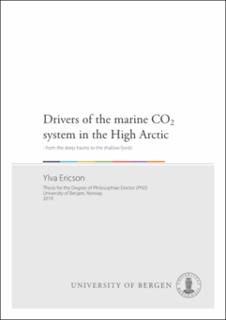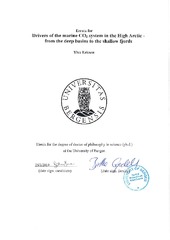| dc.contributor.author | Ericson, Ylva | |
| dc.date.accessioned | 2019-02-21T11:19:15Z | |
| dc.date.available | 2019-02-21T11:19:15Z | |
| dc.date.issued | 2019-02-20 | |
| dc.identifier.uri | https://hdl.handle.net/1956/19131 | |
| dc.description.abstract | The High Arctic is largely undersampled in terms of marine CO2 system data due to the cold dark season and often an extensive sea ice cover. The current understanding of the Arctic carbon cycle is thus vulnerable to both the spatial distribution and the timing of the data that so far exist. The fact that the Arctic is in transition due to the Arctic Amplification of climate change, makes it the more important to fill the knowledge gaps on the carbon cycle that prevail. This thesis is not only an attempt to add data to the existing pool of measurements, but also an investigation of processes that drive changes in the marine CO2 system. The uptake of anthropogenic carbon (Cant) from the atmosphere and the subsequent storage thereof, do not always occur in the same region. The Cant load in the Atlantic Water that flows into the central Arctic Ocean likely explains observed trends of increasing total dissolved inorganic carbon of 0.4-0.9 μmol kg-1 yr-1 at the intermediate depths of the deep Arctic basins. Further up in the water column at depths between 50 to150 m, the signature of organic decay products that originates from the bottom of the river-influenced East Siberian Sea can be traced all the way to the Fram Strait. This rather fresh water type is undersaturated in the calcium carbonate minerals aragonite and calcite and can therefore have negative consequences for shell-building calcifying marine organisms. In Adventfjorden, a fjord branch of the Isfjorden system that is situated on the West Spitsbergen coast, the thermodynamic driving force of the air-sea CO2 flux was mainly governed by biological processes and temperature changes. This likely reflects the absence of sea ice that has prevailed over the last couple of years. The airsea CO2 uptake of 31-36 g C m-2 yr-1 largely balanced the combined effects of primary production and respiration over the annual cycle. Also, the saturation state of aragonite was controlled by biological activity. In the glacier-influenced neighbouring fjord branch, Tempelfjorden, the freshwater discharge accounted for about 25% of the air-sea CO2 uptake over the melt season. The freshwater discharge decreased the aragonite saturation state, but at least a freshwater fraction larger than 50% (lower range of uncertainty) was needed for the water to become undersaturated in the mineral. | en_US |
| dc.language.iso | eng | eng |
| dc.publisher | The University of Bergen | en_US |
| dc.relation.haspart | Paper I: Ericson, Y., Ulfsbo, U., van Heuven, S., Kattner, G., & Anderson, L.G. (2014), Increasing carbon inventory of the intermediate layers of the Arctic Ocean, J. Geophys. Res. Oceans, 119, 2312-2326. The article is available at: <a href="http://hdl.handle.net/1956/19129" target="blank"> http://hdl.handle.net/1956/19129</a> | en_US |
| dc.relation.haspart | Paper II: Anderson, L.G., Ek, J., Ericson, Y., Humborg, C., Semiletov, I., Sundbom, M., & Ulfsbo, A. (2017), Export of calcium carbonate corrosive waters from the East Siberian Sea, Biogeosciences, 14, 1811-1823. The article is available at: <a href="http://hdl.handle.net/1956/19130" target="blank"> http://hdl.handle.net/1956/19130</a> | en_US |
| dc.relation.haspart | Paper III: Ericson, Y., Falck, E., Chierici, M., Fransson, A., Kristiansen, S., Platt, S.M., Hermansen, O., & Myhre, C.L. (2018), Temporal variability in surface water pCO2 in Adventfjorden (West Spitsbergen) with emphasis on physical and biogeochemical drivers, J. Geophys. Res. Oceans, 123, 4888-4905. The article is available at: <a href="http://hdl.handle.net/1956/19008" target="blank"> http://hdl.handle.net/1956/19008</a> | en_US |
| dc.relation.haspart | Paper IV: Ericson, Y., Chierici, M., Falck, E., Fransson, A., Jones, E., & Kristiansen, S. (2018), Seasonal dynamics of the marine CO2 system in Adventfjorden, a West Spitsbergen fjord. The article is not available in BORA. | en_US |
| dc.relation.haspart | Paper V: Ericson, Y., Falck, E., Chierici, M., Fransson, A., & Kristiansen, S. (2018), Marine CO2 system variability in a high Arctic tidewater-glacier fjord system, Tempelfjorden, Svalbard. The article is not available in BORA. | en_US |
| dc.title | Drivers of the marine CO2 system in the High Arctic - from the deep basins to the shallow fjords | en_US |
| dc.type | Doctoral thesis | |
| dc.rights.holder | Copyright the author. All rights reserved | en_US |
| dc.identifier.cristin | 1673377 | |

